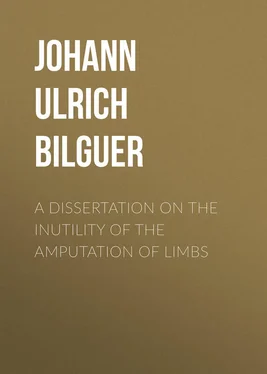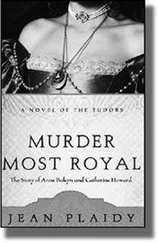Johann Bilguer - A dissertation on the inutility of the amputation of limbs
Здесь есть возможность читать онлайн «Johann Bilguer - A dissertation on the inutility of the amputation of limbs» — ознакомительный отрывок электронной книги совершенно бесплатно, а после прочтения отрывка купить полную версию. В некоторых случаях можно слушать аудио, скачать через торрент в формате fb2 и присутствует краткое содержание. Жанр: foreign_language, foreign_antique, foreign_prose, на английском языке. Описание произведения, (предисловие) а так же отзывы посетителей доступны на портале библиотеки ЛибКат.
- Название:A dissertation on the inutility of the amputation of limbs
- Автор:
- Жанр:
- Год:неизвестен
- ISBN:нет данных
- Рейтинг книги:4 / 5. Голосов: 1
-
Избранное:Добавить в избранное
- Отзывы:
-
Ваша оценка:
- 80
- 1
- 2
- 3
- 4
- 5
A dissertation on the inutility of the amputation of limbs: краткое содержание, описание и аннотация
Предлагаем к чтению аннотацию, описание, краткое содержание или предисловие (зависит от того, что написал сам автор книги «A dissertation on the inutility of the amputation of limbs»). Если вы не нашли необходимую информацию о книге — напишите в комментариях, мы постараемся отыскать её.
A dissertation on the inutility of the amputation of limbs — читать онлайн ознакомительный отрывок
Ниже представлен текст книги, разбитый по страницам. Система сохранения места последней прочитанной страницы, позволяет с удобством читать онлайн бесплатно книгу «A dissertation on the inutility of the amputation of limbs», без необходимости каждый раз заново искать на чём Вы остановились. Поставьте закладку, и сможете в любой момент перейти на страницу, на которой закончили чтение.
Интервал:
Закладка:
In making these incisions, we should take all imaginable care, as I have already remarked, not to wound the larger blood vessels or more considerable nerves; for this purpose, the gangrened parts which lie near them, should be separated with great caution: It is even better to leave behind a small portion of the mortified flesh which may adhere to them, and to trust for its separation to the ensuing dressings, which they will not fail to accomplish. The reason for this rule is, that we often see the vessels remain sufficiently sound, while the other parts are very much corrupted. We find for example, in the arm, near the joint of the elbow, near the wrist, and even in the lower extremities, the vessels intire, although the mortification of the parts which surround them be so considerable, as to oblige us to make our incisions to the bone; and it is these vessels, after the extirpation of the dead parts, that must keep up life in those which remain: We ought to preserve the greatest number we can, not only of the larger vessels, but even of the smaller ones: It was with a view to this particular, that I recommended not to make our incisions rashly, but with a good deal of caution, both with respect to the place where they were made, their direction and their distance. In operating with this circumspection, we shall avoid incurring the censure of Platnerus, who remarks, that we ought not to separate the dead from the sound parts with violence, “Because,” says he, “incisions which cause an effusion of blood, often renew the inflammation.” Now in my method, there is neither any violence, nor incisions attended with blood.
SECT. X
When the incisions are made, if the neighbouring parts appear somewhat tainted, we must, by gentle compression, squeeze out the corrupted humour which may harbour there, and wipe it off with a bit of soft linnen rag. Afterwards, whether it may have been necessary to extract, either with the fingers, a scalpel, or with the instrument called a myrtle leaf 7 7 See Dionis's surgery, page 18. 4th edition.
, any bony splinters too much detached from the substance of the bone itself to hope for a re-union, a circumstance which often requires a considerable dilatation of the fleshy parts; or whether the bones appear carious, or spoiled in any other shape; or, lastly, whether we may have been obliged to make deep incisions, even to the bone: In all these cases, we must at first employ such external applications as are proper for the bones, and for the soft parts that have a tendency to mortification, although they may have discharged a sufficient quantity of blood during these operations.
The bone, whether the periosteum be sound or destroyed, must be dressed with the following medicine: Of frankincense, mastick, sarcocolla and myrrh finely pounded, true balsam of Peru, and genuine essential oil of cloves, of each equal parts; of balsam of Fioraventi, as much as may, in mixing all the ingredients over a very gentle fire, form a thin liniment ; which must be warmed when used, and which must be poured plentifully into the wounds I am speaking of, so that the bone may be well moistened therewith.
This medicine is of service in all cases where the bone is affected. When the bone is covered with it, some dry lint may be laid over it, and the soft parts dressed by sprinkling upon this lint a powder composed of an ounce of myrrh finely pounded, half an ounce of sal ammoniac, camphor and nitre, each a dram . After the first layer of lint is thus covered, fresh lint must be applied, and again sprinkled with the powder, till in this manner the cavity of the wound is quite filled up with alternate layers of lint, and this vulnerary powder.
SECT. XI
If the bone is not affected, or the periosteum laid bare, the balsam or thin liniment may be omitted. And the dressings may only consist of the layers of dry lint and vulnerary powder applied alternately.
SECT. XII
Besides the dressings I have mentioned ( § X. SECT. X When the incisions are made, if the neighbouring parts appear somewhat tainted, we must, by gentle compression, squeeze out the corrupted humour which may harbour there, and wipe it off with a bit of soft linnen rag. Afterwards, whether it may have been necessary to extract, either with the fingers, a scalpel, or with the instrument called a myrtle leaf 7 7 See Dionis's surgery, page 18. 4th edition. , any bony splinters too much detached from the substance of the bone itself to hope for a re-union, a circumstance which often requires a considerable dilatation of the fleshy parts; or whether the bones appear carious, or spoiled in any other shape; or, lastly, whether we may have been obliged to make deep incisions, even to the bone: In all these cases, we must at first employ such external applications as are proper for the bones, and for the soft parts that have a tendency to mortification, although they may have discharged a sufficient quantity of blood during these operations. The bone, whether the periosteum be sound or destroyed, must be dressed with the following medicine: Of frankincense, mastick, sarcocolla and myrrh finely pounded, true balsam of Peru, and genuine essential oil of cloves, of each equal parts; of balsam of Fioraventi, as much as may, in mixing all the ingredients over a very gentle fire, form a thin liniment ; which must be warmed when used, and which must be poured plentifully into the wounds I am speaking of, so that the bone may be well moistened therewith. This medicine is of service in all cases where the bone is affected. When the bone is covered with it, some dry lint may be laid over it, and the soft parts dressed by sprinkling upon this lint a powder composed of an ounce of myrrh finely pounded, half an ounce of sal ammoniac, camphor and nitre, each a dram . After the first layer of lint is thus covered, fresh lint must be applied, and again sprinkled with the powder, till in this manner the cavity of the wound is quite filled up with alternate layers of lint, and this vulnerary powder.
and § XI. SECT. XI If the bone is not affected, or the periosteum laid bare, the balsam or thin liniment may be omitted. And the dressings may only consist of the layers of dry lint and vulnerary powder applied alternately.
) for these kinds of wounds, we must likewise make slight scarifications upon the neighbouring parts, and sprinkle them with the powder; after this treatment, embrocate all the sores with oil of turpentine, and then lightly bandage up the whole with plain linnen cloth, which must be kept moistened, night and day, with warm fomentations.
SECT. XIII
It is in following this method only, ( § X SECT. X When the incisions are made, if the neighbouring parts appear somewhat tainted, we must, by gentle compression, squeeze out the corrupted humour which may harbour there, and wipe it off with a bit of soft linnen rag. Afterwards, whether it may have been necessary to extract, either with the fingers, a scalpel, or with the instrument called a myrtle leaf 7 7 See Dionis's surgery, page 18. 4th edition. , any bony splinters too much detached from the substance of the bone itself to hope for a re-union, a circumstance which often requires a considerable dilatation of the fleshy parts; or whether the bones appear carious, or spoiled in any other shape; or, lastly, whether we may have been obliged to make deep incisions, even to the bone: In all these cases, we must at first employ such external applications as are proper for the bones, and for the soft parts that have a tendency to mortification, although they may have discharged a sufficient quantity of blood during these operations. The bone, whether the periosteum be sound or destroyed, must be dressed with the following medicine: Of frankincense, mastick, sarcocolla and myrrh finely pounded, true balsam of Peru, and genuine essential oil of cloves, of each equal parts; of balsam of Fioraventi, as much as may, in mixing all the ingredients over a very gentle fire, form a thin liniment ; which must be warmed when used, and which must be poured plentifully into the wounds I am speaking of, so that the bone may be well moistened therewith. This medicine is of service in all cases where the bone is affected. When the bone is covered with it, some dry lint may be laid over it, and the soft parts dressed by sprinkling upon this lint a powder composed of an ounce of myrrh finely pounded, half an ounce of sal ammoniac, camphor and nitre, each a dram . After the first layer of lint is thus covered, fresh lint must be applied, and again sprinkled with the powder, till in this manner the cavity of the wound is quite filled up with alternate layers of lint, and this vulnerary powder.
, XI SECT. XI If the bone is not affected, or the periosteum laid bare, the balsam or thin liniment may be omitted. And the dressings may only consist of the layers of dry lint and vulnerary powder applied alternately.
, XII SECT. XII Besides the dressings I have mentioned ( § X. SECT. X When the incisions are made, if the neighbouring parts appear somewhat tainted, we must, by gentle compression, squeeze out the corrupted humour which may harbour there, and wipe it off with a bit of soft linnen rag. Afterwards, whether it may have been necessary to extract, either with the fingers, a scalpel, or with the instrument called a myrtle leaf 7 7 See Dionis's surgery, page 18. 4th edition. , any bony splinters too much detached from the substance of the bone itself to hope for a re-union, a circumstance which often requires a considerable dilatation of the fleshy parts; or whether the bones appear carious, or spoiled in any other shape; or, lastly, whether we may have been obliged to make deep incisions, even to the bone: In all these cases, we must at first employ such external applications as are proper for the bones, and for the soft parts that have a tendency to mortification, although they may have discharged a sufficient quantity of blood during these operations. The bone, whether the periosteum be sound or destroyed, must be dressed with the following medicine: Of frankincense, mastick, sarcocolla and myrrh finely pounded, true balsam of Peru, and genuine essential oil of cloves, of each equal parts; of balsam of Fioraventi, as much as may, in mixing all the ingredients over a very gentle fire, form a thin liniment ; which must be warmed when used, and which must be poured plentifully into the wounds I am speaking of, so that the bone may be well moistened therewith. This medicine is of service in all cases where the bone is affected. When the bone is covered with it, some dry lint may be laid over it, and the soft parts dressed by sprinkling upon this lint a powder composed of an ounce of myrrh finely pounded, half an ounce of sal ammoniac, camphor and nitre, each a dram . After the first layer of lint is thus covered, fresh lint must be applied, and again sprinkled with the powder, till in this manner the cavity of the wound is quite filled up with alternate layers of lint, and this vulnerary powder. and § XI. SECT. XI If the bone is not affected, or the periosteum laid bare, the balsam or thin liniment may be omitted. And the dressings may only consist of the layers of dry lint and vulnerary powder applied alternately. ) for these kinds of wounds, we must likewise make slight scarifications upon the neighbouring parts, and sprinkle them with the powder; after this treatment, embrocate all the sores with oil of turpentine, and then lightly bandage up the whole with plain linnen cloth, which must be kept moistened, night and day, with warm fomentations.
.) that these fomentations, so much recommended both by the antients and moderns, will be found truly serviceable and efficacious. Mr. Heister has collected a sufficient number of these forms, in treating of mortifications, in his excellent system of surgery, which is in every body's hands. It will be an easy matter for a surgeon, who understands the nature of the ailment and the quality of the medicines, to select such as will be most suitable to the case he happens to treat. Thus, for example, the fomentation consisting of a pint of lime water, three ounces of camphorated spirit of wine, and an ounce or half an ounce of sal ammoniac , is very useful in mortifications which are the consequences of high inflammation, as it relieves the inflamed parts that lie round those which are already mortified. The same effect may be obtained from the fomentation made with the balsam of life ; namely, soap, salt of tartar, and oil of turpentine, mixed and dissolved in lime-water ; and from the cataplasm , composed of the herbs called species pro cataplasmate , and venice soap and saffron added thereto 8 8 These two last applications are not in Heister: The species pro cataplasmatic , consists of yarrow, wormwood, water germander, southernwood, chamomile, sage, hysop, rue, elder, St. John's wort, and red roses . It is quite unnecessary to make use of all these ingredients at one time. Tissot.
.
Интервал:
Закладка:
Похожие книги на «A dissertation on the inutility of the amputation of limbs»
Представляем Вашему вниманию похожие книги на «A dissertation on the inutility of the amputation of limbs» списком для выбора. Мы отобрали схожую по названию и смыслу литературу в надежде предоставить читателям больше вариантов отыскать новые, интересные, ещё непрочитанные произведения.
Обсуждение, отзывы о книге «A dissertation on the inutility of the amputation of limbs» и просто собственные мнения читателей. Оставьте ваши комментарии, напишите, что Вы думаете о произведении, его смысле или главных героях. Укажите что конкретно понравилось, а что нет, и почему Вы так считаете.












